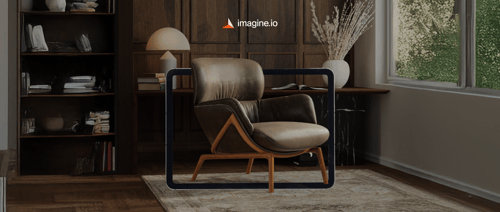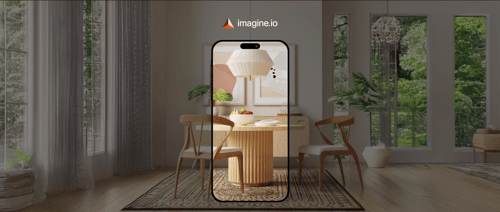Walk into any product showroom, ecommerce platform, or social feed in 2025, and you’ll see it—home décor is no longer about playing it safe. It’s about storytelling. It’s about identity. It’s about connecting with the buyer’s evolving tastes, shaped by a world that’s more digital, diverse, and design-forward than ever before.
As someone who’s been deep in the content, design, and commerce space for over a decade, I’ve seen trends come and go. But this year feels different. Home décor in 2025 is undergoing a creative renaissance. And for brands, manufacturers, and visual merchandising teams, the question isn’t just what’s trending, but how quickly and authentically can we reflect that in our product visuals?
Let’s explore what’s shaping this transformation—and how your team can stay ahead without the logistical chaos.
Get the latest updates straight to your inbox.
By clicking sign up you'll receive occasional emails from imagine.io. You always have the choice to unsubscribe within every email you receive.
1. Curated Maximalism: More Soul, Less Chaos

Why It’s Relevant: Maximalism is trending, but not in the cluttered, overstimulating way of the past. Today’s consumer prefers layered, personal spaces that feel collected, not chaotic. They’re drawn to styling that communicates a life well-lived—through art, textiles, books, and meaningful objects.
Styling Strategies:
- Blend elements thoughtfully: mix books, ceramics, plants, and art, but ensure each item has purpose.
- Embrace layered compositions like gallery walls or shelf vignettes, set against clean, balanced backgrounds to reduce noise.
- Platforms like imagine.io make this easier by allowing you to digitally swap props, art pieces, and plant varieties without restaging everything.
B2B Takeaway: Narrative styling deepens buyer engagement—and digital styling tools let you iterate faster, without reshooting.
2. The Fall of “Vanilla” Décor
Why It’s Relevant: The beige-on-beige trend is losing appeal. The early 2020s’ obsession with neutrals and bouclé left little room for personality. Today’s buyers want interiors that reflect individuality—through rich textures, purposeful color, and expressive accents.
Styling Strategies:
- Add controlled contrast with vibrant throws, patterned pillows, or accent chairs.
- Style scenes with ambient lighting and real-life touches—a tea cup on a side table, open books, or filtered natural light through curtains.
- With imagine.io, your team can quickly test bold versus neutral setups, or add a pop of color to an existing scene with minimal effort.
B2B Takeaway: Color and texture elevate perceived value—and styling tools help you strike the right balance for your audience.
3. Retro Revival: Nostalgia with a Modern Edge
Why It’s Relevant: Nostalgic design elements—'70s warmth, '80s curves, '90s graphics, Art Deco elegance—are making a confident return. This revival isn’t about mimicry; it’s about modern interpretation. It taps into familiarity and emotion while keeping visuals fresh.
Styling Strategies:
- Use materials like rattan, velvet, brass, and natural woods for a vintage foundation.
- Add playful touches: pastel ceramics, Memphis-inspired cushions, or arched mirrors.
- imagine.io enables you to preview these retro styling layers before committing—saving time and offering flexibility in visual experimentation.
B2B Takeaway: Retro design builds emotional resonance. Modern digital styling ensures speed, consistency, and creative agility.
4. Global Layering & Cultural Storytelling
Why It’s Relevant: Consumers are embracing global design narratives—not for trend value, but for the authenticity and richness they bring. A Moroccan rug or Japanese teacup isn’t just a visual element—it’s part of a cultural story buyers want to connect with.
Styling Strategies:
- Mix and match globally sourced textures and materials: African baskets, Indian block prints, Japanese pottery, Scandinavian furniture.
- Highlight craftsmanship in close-up shots that show texture and detail.
- imagine.io lets you vary props by region or theme and cite origin, ensuring your visuals are both diverse and respectful.
B2B Takeaway: Cultural authenticity builds trust—and scalable styling tools allow you to represent that narrative accurately and affordably.
5. Biophilic Comfort: Wellness in Focus

Why It’s Relevant: Wellness continues to be a top driver in home design. Consumers are turning their spaces into sanctuaries, and brands that reflect nature-inspired styling—both in product and presentation—are seeing stronger emotional responses.
Styling Strategies:
- Use organic textures: raw woods, natural stone, linen, and hand-thrown ceramics.
- Layer in greenery—tall plants, windowsill herbs, hanging foliage—and let sunlight play an active role in your compositions.
- With imagine.io, you can build and test biophilic environments, adjusting lighting, plant types, and finishes in seconds.
B2B Takeaway: Wellness sells, and the ability to visually communicate it with ease can drive faster product decisions and emotional engagement.
6. Curves & Organic Forms: Soften the Space
Why It’s Relevant: In contrast to rigid minimalism, curves and flowing forms evoke calm, comfort, and flexibility. They’re especially effective in multifunctional rooms where visual softness helps define mood and movement.
Styling Strategies:
- Anchor scenes with curved sofas, circular tables, or sculptural lighting.
- Contrast with straighter-edge accessories to maintain visual interest and hierarchy.
- imagine.io’s configurator lets you toggle these shape dynamics to study spatial flow and visual resonance.
B2B Takeaway: Curved elements speak the emotional language of design—modern styling tools help you explore them creatively and at scale.
7. Whimsical Accents & Glimmers of Joy

Why It’s Relevant: A little playfulness goes a long way. Consumers are seeking joy in the everyday, and small, quirky design choices—like a donut-shaped vase or a smiley-face pillow—add surprise and charm.
Styling Strategies:
- Add one or two unexpected elements to a room: a novelty lamp, a fruit-themed tray, or hand-painted ceramics.
- Keep the rest of the setting grounded, letting the whimsical item draw the eye without overwhelming the scene.
- With imagine.io, you can test different props and gauge how subtle whimsy shifts the emotional tone of a space.
B2B Takeaway: Joy sells—and styling tools give you the creative freedom to strike the perfect balance between serious design and lighthearted appeal.
8. Hybrid & Multifunctional Living
Why It’s Relevant: The way we use our spaces has fundamentally shifted. Homes now serve multiple roles—work, rest, exercise, and entertainment—all within the same square footage. Your visuals need to reflect that functional flexibility.
Styling Strategies:
- Highlight multipurpose furniture: ottomans with storage, fold-out desks, sofa beds, and modular shelving.
- Style the same room in multiple configurations: a workspace by day, a media lounge by night.
- With imagine.io’s rapid scene editing, you can showcase various use-case setups using a single base file—saving on time, logistics, and cost.
B2B Takeaway: Multifunctional visuals resonate with real-life buyers. The ability to toggle and restyle scenes makes your content more dynamic, relatable, and effective.
Conclusion
Styling trends in 2025 are moving beyond sterile perfection. They’re becoming curated, expressive, globally inspired, and responsive to how people really live. As a leader in brand or merch, embracing these visual directions can enhance authenticity, engagement, and alignment with evolving consumer values.
With imagine.io, teams can rapidly prototype, iterate, and deploy visuals that reflect these key trends—without the time, cost, or logistics of physical reshoots. Your next step? See how effortlessly curated, dynamic styling can scale across your visual content.
Book a Demo with imagine.io today and start bringing richer, more human home environments to life—digitally.
.png?width=1440&name=Styling%20Home%20Decor%20for%202025_%20From%20Global%20Influences%20to%20Playful%20Personalization%20(1).png)

.gif?width=1296&height=1296&name=Untitled%20design%20(8).gif)




.png?width=500&name=How%20to%20Add%20a%203D%20Product%20Configurator%20to%20Your%20WordPress%20Website%20(Complete%20B2B%20Guide).png)
















%20(1).png?width=500&name=Why%20Exploded%20Mattress%20Views%20Matter%20(And%20How%20to%20Generate%20Them)%20(1).png)
.png?width=500&name=Best%20Shopify%20Product%20Configurator_%20How%20to%20Choose%20the%20Right%20One%20(2).png)
.png?width=500&name=Why%20Exploded%20Mattress%20Views%20Matter%20(And%20How%20to%20Generate%20Them).png)



.png?width=500&name=Best%20Shopify%20Product%20Configurator_%20How%20to%20Choose%20the%20Right%20One%20(1).png)







.png?width=500&name=How%203D%20Rendering%20Can%20Make%20or%20Break%20Your%20Industrial%20Design%20Pitch%20(1).png)








%20with%20Digital%20Twins%20and%203D%20Visualization.png?width=500&name=Optimizing%20Your%20Digital%20Asset%20Management%20(DAM)%20with%20Digital%20Twins%20and%203D%20Visualization.png)




.png?width=500&name=Styling%20Home%20Decor%20for%202025_%20From%20Global%20Influences%20to%20Playful%20Personalization%20(1).png)
